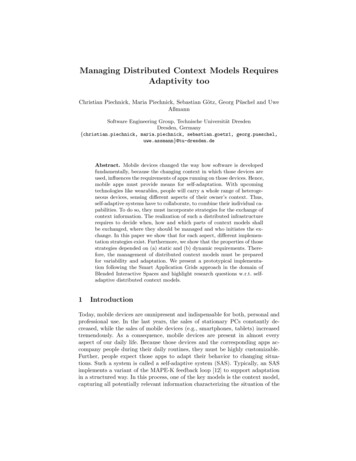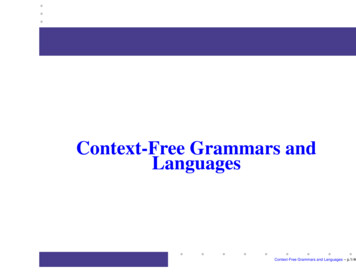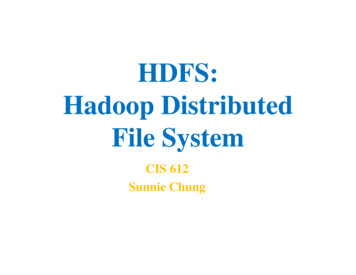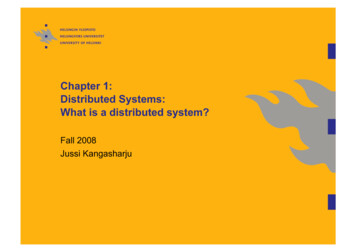
Transcription
Managing Distributed Context Models RequiresAdaptivity tooChristian Piechnick, Maria Piechnick, Sebastian Götz, Georg Püschel and UweAßmannSoftware Engineering Group, Technische Universität DresdenDresden, Germany{christian.piechnick, maria.piechnick, sebastian.goetz1, georg.pueschel,uwe.assmann}@tu-dresden.deAbstract. Mobile devices changed the way how software is developedfundamentally, because the changing context in which those devices areused, influences the requirements of apps running on those devices. Hence,mobile apps must provide means for self-adaptation. With upcomingtechnologies like wearables, people will carry a whole range of heterogeneous devices, sensing different aspects of their owner’s context. Thus,self-adaptive systems have to collaborate, to combine their individual capabilities. To do so, they must incorporate strategies for the exchange ofcontext information. The realization of such a distributed infrastructurerequires to decide when, how and which parts of context models shallbe exchanged, where they should be managed and who initiates the exchange. In this paper we show that for each aspect, different implementation strategies exist. Furthermore, we show that the properties of thosestrategies depended on (a) static and (b) dynamic requirements. Therefore, the management of distributed context models must be preparedfor variability and adaptation. We present a prototypical implementation following the Smart Application Grids approach in the domain ofBlended Interactive Spaces and highlight research questions w.r.t. selfadaptive distributed context models.1IntroductionToday, mobile devices are omnipresent and indispensable for both, personal andprofessional use. In the last years, the sales of stationary PCs constantly decreased, while the sales of mobile devices (e.g., smartphones, tablets) increasedtremendously. As a consequence, mobile devices are present in almost everyaspect of our daily life. Because those devices and the corresponding apps accompany people during their daily routines, they must be highly customizable.Further, people expect those apps to adapt their behavior to changing situations. Such a system is called a self-adaptive system (SAS). Typically, an SASimplements a variant of the MAPE-K feedback loop [12] to support adaptationin a structured way. In this process, one of the key models is the context model,capturing all potentially relevant information characterizing the situation of the
application [4]. Especially in the application area of mobile apps, the knowledgeof a single application is usually not sufficient to support more sophisticateddecision making. The first reason is that mobile applications are rather small,specialized applications with a limited set of offered functionality. Thus, a singleapp has a limited scope w.r.t. the execution context. To expand this scope, multiple apps have to work together to combine their individual knowledge. Thoseapps, however, potentially were implemented by different developers and runin isolation. Consequently, generic approaches for the exchange of context information are required. Furthermore, even today, people carry a whole rangeof heterogeneous devices (e.g., smart watch, fitness trackers), sensing differentaspects of their owner’s context. In addition, hardware constantly gets cheaperand communicates on standard and open protocols. This paves the way for smartenvironments (smart home, smart office, etc.) consisting of different sensors andactuators, that can dynamically be integrated in the feedback loop of personaldevices. Those developments are the enablers for ideas like Blended InteractionSpaces (BI Spaces), which are ubiquitous computing environments for computersupported collaboration [10]. Within those environments, heterogeneous deviceswork together seamlessly, to support collaborative workflows in physical spaces(e.g., rooms). BI Spaces must be highly adaptive w.r.t. the different users, tasks,requirements, devices, modalities, and interaction styles. Thus, applications ina BI Space must exchange contextual information. While the management oflocal context models is well investigated, one of the major challenges of todaysself-adaptive systems is the management of distributed context models.In the last decade, numerous solutions for the exchange of context information were realized, based on application-specific requirements. Investigating thosesolutions, we have identified 5 different aspects: (1) What information is accessible, (2) When context information should be exchanged, (3) Who initiatesthe exchange, (4) Where the information should be managed and (5) Howretrieved information should be managed. We show that for answering thosequestions, different strategies exist having different benefits and drawbacks. Wehighlight that the corresponding requirements can change during runtime. Forthis reason, the context management itself should be self-adaptive. By now, tothe best of our knowledge, no holistic approach for distributed context modelmanagement exists, which provides the required flexibility to self-adapt according to the five above questions. The intention of this work is to provide an initialcategorization of different interaction strategies for the adaptive exchange ofcontext information. In this paper, we show how an infrastructure for adaptiveexchange of context information can be implemented with Smart ApplicationGrids (SMAGs), an approach for the development and execution of self-adaptivesystems, supporting Meta-Adaptation, from our previous work [16].This paper is structured as follows, in Section 2 we present five differentaspects w.r.t. the exchange of contextual information and the correspondingimplementation strategies. In Section 3 we present a prototypical implementationof self-adaptive exchange infrastructure based on the SMAGs technology. Finally,in Section 4 we summarize our work and highlight important research topics.
2Distributed Context Model ManagementIn scenarios where distributed SAS must work together to extend the individualknowledge bases (e.g., using a smart watch to improve the activity tracking ofa smartphone), the system developers must provide means for the exchange ofcontext information. Usually, a central feedback loop managing all self-adaptiveapplications is not feasible. Thus, the overall architecture consist of multiple collaborating feedback loops, executed on distributed, heterogeneous devices. Onepossible interaction is the exchange of monitored and potentially analyzed context information. In recent years, researchers have implemented different strategies to support context information exchange, based on their application-specificrequirements. We have investigated 16 publications that support the ability toexchange context information [1–3, 5–9, 11, 13, 14, 17–21]. While analyzing theliterature, we have identified the following application-specific requirements: architectural flexibility, limited number of required connections, low data traffic,high expressiveness, small size of the individual models, high reasoning performance, fault-tolerance and the ability to handle privacy constraints. The decision,which strategy should be used, depends on the individual static or dynamic requirements. To the best of our knowledge, the possible variation points as wellas the corresponding implementation strategies for distributed context management have not been documented, yet. We have identified 5 aspects, the designerof a distributed context model management infrastructure has to cope with,regarding the exchange of contextual information. In some cases, the decision,which strategy should be used, can only be made at runtime. Thus, the contextmodel management infrastructure must provide means for dynamic reconfiguration and must be subject to the system’s feedback-loop, as well. If the samemechanisms are applied as for the adaptation of the business functionality, suchan ability is called Meta-Adaptation. In this work, we assume that the distributedself-adaptive systems are able to find each other, can communicate and use ahomogenous context model formalism and type system. We will use the termSource for the SAS sending context information to a Sink.2.1What Context Information Should be Exchanged?This question focuses on the accessible content (see Figure 2.1). When all participating applications are developed by the same authorities, the access to theentire context model might be feasible. In more open scenarios, the access toprivate information must be restricted.SourceSink(1.a) CompleteSourceSink(1.b) PartialSourceSink(1.c) View-BasedFig. 1. What context information should be exchanged
Complete: The most common solution is to give any other application fullaccess to the entire context model [1, 5–7, 9, 11, 21]. In this case, the context sink can decide which information may be relevant for its own decisionmaking. On the other hand, however, for many applications this is not applicable, because of privacy issues. Furthermore, depending on the amountof context information and the update frequency, this approach leads to anincreased data traffic. With an increasing number of collaboration partners,the amount of data might exceed the limit of the processing capabilities.Partial In many cases, not all context information (a) should be accessibleby [21] and (b) is relevant for a context-sink [5, 8, 13, 14, 17, 18, 20]. Therefore, the context-source might restrict access to certain information and/orthe context-sink has the ability to exclude irrelevant information. This mayimprove privacy properties and reduces traffic as well as the overall amountof exchanged context information.View-based Another possibility is to build views on a context model [2,3,5,17,19]. This approach enables explicit privacy handling. Furthermore, the datatraffic may be reduced, because views can describe abstractions of contextinformation. The views can either be defined by the source or by the sink(e.g., queries with projection).2.2When Context Information Should be Exchanged?This aspect focuses on the point of time and the circumstances, under whichcontext information should be exchanged (see Figure 2.2). This is important tolimit the amount of transferred data over time.Sourceevery nseconds(2.a) PeriodicallySinkSourceEventProcessing(2.b) Event-basedSinkSourceMAEPSink(2.c) Context-basedFig. 2. When Context Information Should be ExchangedPeriodically In this strategy the information is either pulled by or pushed tothe sink in certain time intervals [6, 7, 11]. The update frequency might bedefined statically, depending on the category of information, or dynamicallybased on dynamic requirements. Especially for applications with highly frequent context updates, it is important to adjust the frequency accordingly,to prevent subsampling.Event-based In contrast to periodic updates, this strategy triggers the exchange of contextual information based on events (e.g., explicit exchangerequest etc.), either fired by the source or the sink [3, 9, 11, 13, 14, 18–20]. Inthis approach the source and the sink have more influence on the exchangelogic.
Context-based The exchange of context information can also be specifiedcontext-dependent [2, 5]. In this strategy, a feedback loop decides based onthe available context information (e.g., two devices are very close), when theexchange of contextual information should be initiated.2.3Who Initiates the Exchange of Context Information?This aspect focuses on the participant, initiating the exchange (see Figure 2.3).For some applications, the source has the knowledge when the exchange shouldbe initiated, in other scenarios the sink.12SourceSink(3.a) SourceSourceSink(3.b) SinkSourceSink(3.c) NegotiationFig. 3. Who Initiates the Exchange of Context InformationSource In this strategy the source proactively distributes context informationto sinks [1, 3, 5, 9, 14, 18]. In contrast to sink-side initiation, the sink maynot be able to specify which information is interesting in a certain situation.On the other hand, the source has full control over it’s data and how it isdistributed.Sink Another variant is that sink pulls context-information from a source [5–7,11,17,19,20]. For this approach, the source application has to offer a contextquery interface which enables the sink to retrieve information. Usually, thisis combined with a periodic update mechanism.Negotiation The sink- and source-based initiation can be combined in a blackboardbased architecture [2, 13, 17]. Sinks can access the context-model of a sourcevia a query interface and retrieve data. The server might grant or deny accessand might offer customized views. Sinks may be able to register for certainevents (e.g., the temperature changed) and the source will notify the sinkswhen those events occur. This strategy is more complex and more expensiveto implement. On the other hand, it offers more flexibility w.r.t. data trafficand privacy issues.2.4Where Should Context Information be Managed?This question focuses on the location, where the context model data should bestored (see Figure 2.4. Especially for resource-limited devices it is necessary tooutsource the context management and processing to more capable devices.
Source SensorsS/SSensors SourceS/SSink(4.a) CentralizedS/S(4.b) DecentralizedS/SSourceSource/SinkSSSS/SSource(4.c) HybridFig. 4. Where Should Context Information be ManagedCentralized In this approach, a central system manages the context information of the participating self-adaptive systems [1, 3, 7, 11]. This decreases thenumber of required connections and data traffic. For devices with limited resources (e.g., CPU, main memory) this approach might be beneficial, becausepotentially large data sets and the corresponding reasoning mechanism canbe outsourced. On the other hand, this approach introduces a single pointof failure and makes privacy handling rather difficult.Decentralized In contrast to the centralized approach, context models can bemanaged completely decentralized. Thereby, every application manages itsown context model and can exchange context information with other applications [2, 5, 6, 9, 13, 14, 17, 19–21]. This approach makes privacy handlingeasier, since every application can decide whether or not certain information should be shared with a collaboration partner. Furthermore, this willdecrease the size of the context models and increases the performance ofthe specific reasoning processes. On the other hand, this approach leads toa higher number of connections (i.e., combinatorial in the worst case) andincreased data traffic.Hybrid In situations where neither a fully centralized, nor a fully decentralizedapproach is feasible, the benefits of both architectures can be combined ina hybrid approach, with multiple central context managing applications [8,18]. The individual source applications transfer their context informationto a sink. The sink however might exchange information in a decentralizedway. The concrete architecture can either be modeled statically, when allparticipating applications or application types are known, or dynamicallywhen the appropriate architecture depends on dynamic information (e.g.,the context). This may limit the number of connections and decreases datatraffic, while still being able to handle privacy issues.2.5How Should the Distributed Context Information be Managed?This question focuses on the strategies, how the context information should bestored (see Figure 2.5). Commonly, the received context information might becopied to the context model of the client. Sometimes, it is better to just store areference to the actual data stored in the context model of the source.Copy The most common strategy, to include the received contextual information in the client’s context model, is by copying the received elements inthe knowledge base [1, 5–7, 11, 13, 14, 18, 20, 21]. This strategy is easy to
SourceClient(5.a) CopySourceClient(5.b) ProxySourceClient(5.c) HybridFig. 5. How Should the Distributed Context Information be Managedimplement and is suitable for situations, where the number of reads of thecopied elements (i.e., during reasoning) is similar to the number writes (i.e.,reception of updated information).Proxy When the number of writes of received context information exceeds thenumber of reads, it might be beneficial to only store a reference to the originalinformation [2, 8]. This decreases the size of the stored model as well as thedata traffic. On the other hand, the reasoning performance is decreased whenthe remotely managed information must be transferred on-demand.Hybrid In situations where neither the concrete elements within the contextmodel nor their characteristics (e.g., value range, update frequency, number of reads, degree of distribution) is known during design time, a hybridapproach can be applied [3, 17, 19]. The sink could start copying the values. When the number of updates exceeds the number of reads, the sinkcan switch to a proxy-based approach. This strategy introduces additionalcomplexity, since additional monitoring and decision making algorithms areneeded, on the other hand, this might decrease data traffic and the size ofthe managed model.3An Examplary Self-Adaptive Context ExchangeSolution with SMAGsTo show the feasibility of runtime adaptation of distributed context model management we have implemented a small exemplary application with one adaptation, dynamically switching from a copy- to a proxy-based information management strategy (see Subsection 2.5). As one of multiple options, we have usedthe Smart Application Grids (SMAGs) approach to implement our solution, because it was developed within our group and supports Meta-Adapation natively.We expect meta-adaptation to be a feature of any middleware for self-adaptivesystems. In SMAGs, self-adaptive systems are modeled and implemented ascomponent-based systems and uses role-based programming for adaptation [15].In contrast to many other platforms for self-adaptive systems, the adaptationmechanisms are developed in the same technological space as the self-adaptivesystems itself. This enables Meta-Adaptation, by adapting the feedback loopitself at runtime [16]. Our example application originates from the domain ofBlended Interactive Spaces, implementing the ”Bump-to-Give Gesture”. In thescenario, a sender application running on Device A sends a file (e.g., an image)
to a receiver application running on Device B, when those devices are bumpedtogether. To implement such a scenario one must detect (1) when two devicesare physically near (e.g., using the RSSI value of the Bluetooth sensor) and (2)that those devices were bumped together (e.g., using the accelerometer of the respective devices). To avoid misinterpretations, a plausibility check is performedby analyzing the proxemics as well as the motion interpretation of both devices.In our first implementation, the adaptation logic was completely implementedon Device A, while Device B pushed all the context information to the firstdevice. This solution was easy to implement, since all synchronization and interpretation artefacts could reside in one application. For testing, we used twoSamsung Galaxy S5 devices running Android 5.0. The accelerometer has anaverage sampling rate of about 90Hz, while the RSSI update frequency usingBluetooth Low Energy in ”Low Latency” mode, has a sampling rate of 10Hz.Overall, this approach leads to an average bandwidth of about 20 kB/s, percollaborating device. Furthermore, about 100 nodes are added to the contextmodel of Device A per second, per collaborating device. In more realistic scenarios, usually more than 2 devices are involved, leading to high data rates andmodel sizes. The average latency for data evaluation in case of an actual bumpto-give gesture was about 49ms on local Wi-Fi. For improving the situation wehave implemented a role for monitoring the reads/writes of remotely obtainedcontext values. When the number of writes exceeds the number of reads to aratio of 2:1, instead of updating the actual values, a proxy is created, whichredirects the read to a remote call to the actual data. Thus, updates must notbe pushed or pulled constantly. This approach decreases the data rate to almost0 kB/s, since the accelerometer data of Device B is only evaluated, when abump-gesture was detected on Device A. On the other hand, however, when abump occurs, the reasoning performance is decreased to 337 ms. Especially, forsuch visual reactions, the latency is perceivable.This example is just an indication how self-adaptive distributed context management can be realized, not a full evaluation. In future, the possible realizationsof the individual strategies must investigated exhaustively.4Conclusion and Future WorkIn a world where people carry multiple devices and enter interactive intelligentspaces with a wide range of heterogeneous sensors and actuators, the distributedself-adaptive systems running on those devices must be able to dynamically exchange context information. In recent years many application-specific solutionswere developed, meeting the requirements of the individual use-cases. In thiswork we have presented 5 different aspects that have to be considered w.r.t.exchange of contextual information. Furthermore, we have documented the different implementation strategies that were used in solutions or projects thatsupport the management of distributed context information. This categorizationshould help developers to find a proper implementation strategy when designing and implementing solutions for distributed context models. Furthermore,
it is also possible to change the concrete strategies at runtime. This requiresto adapt the feedback loop and the context model management at runtime.Such an approach is called Meta-Adaptation. In addition, we have described afirst prototypical implementation of a self-adaptive distributed context modelmanagement infrastructure using the Smart Application Grids approach in aBlended Interaction scenario. We have shown that the choice of a certain strategy might depend on dynamic context information, and thus, must be subjectto adaptation as well. We think that this work is a starting point to an extensiveinvestigation of variability in distributed context model management. We haveonly used a rather limited number of publications to develop a categorization.The presented categorization must either be confirmed or extended in a moreextensive study. An exhaustive investigation w.r.t. realization possibilities mustdone. Furthermore, the non-functional properties of the different implementationstrategies must be examined extensively. In addition, it should be investigatedhow the additional complexity influences the performance and the maintainability of the self-adaptive systems. Currently, there is no generic solution for copingwith distributed context models that rely on different modeling formalisms andheterogeneous type systems. With the ability to adapt and extend the contextmodel management of an application’s feedback loop opens up the possibilityto provide adapters for bridging technological spaces. This situation, however,is very likely to occur in open scenarios with heterogeneous devices and apps ofdifferent vendors and developers.AcknowledgmentThis work is supported by the German Federal Ministry of Education and Research (BMBF) within the project “SysPlace” (FKZ: 01—S14018E).References1. Broekstra, J., Kampman, A., Harmelen, F.v.: Sesame: A generic architecture forstoring and querying rdf and rdf schema. In: Proceedings of the First InternationalSemantic Web Conference on The Semantic Web. pp. 54–68. ISWC ’02, SpringerVerlag, London, UK, UK (2002)2. Bures, T., Gerostathopoulos, I., Hnetynka, P., Keznikl, J., Kit, M., Plasil, F.:Deeco: An ensemble-based component system. In: Proceedings of the 16th International ACM Sigsoft Symposium on Component-based Software Engineering. pp.81–90. CBSE ’13, ACM, New York, NY, USA (2013)3. Cheng, S.W., Huang, A.C., Garlan, D., Schmerl, B., Steenkiste, P.: An architecture for coordinating multiple self-management systems. In: Proceedings of the4th Working IEEE/IFIP Conference on Software Architectures (WICSA4). Oslo,Norway (11-14 June 2004)4. Dey, A.K.: Understanding and using context. Personal Ubiquitous Comput. 5(1),4–7 (Jan 2001)5. Dey, A.K., Abowd, G.D., Salber, D.: A conceptual framework and a toolkit forsupporting the rapid prototyping of context-aware applications. Hum.-Comput.Interact. 16(2), 97–166 (Dec 2001)
6. Dobrican, R.A., Zampunierisl, D.: Moving towards a distributed network of proactive, self-adaptive and context-aware systems. In: In Proceedings of the Sixth International Conference on Adaptive and Self-Adaptive Systems and Applications2014 (ADPATIVE 2014). pp. 22–26. ThinkMind, Venice, Italy (2014)7. Götz, S., Wilke, C., Schmidt, M., Cech, S., Waltsgott, J., Fritzsche, R.: Theatreresource manager interface specification v. 1.0. Tech. Rep. TUD-FI10-08, ISSN1430-211X, Technische Universitt Dresden (December 2010)8. Hess, C., Romn, M., Campbell, R.: Building applications for ubiquitous computingenvironments. In: Pervasive Computing, Lecture Notes in Computer Science, vol.2414. Springer Berlin (2002)9. de la Iglesia, D.G.: A Formal Approach for Designing Distributed Self-AdaptiveSystems. dissertation, Linaeus University (2014)10. Jetter, H.C., Reiterer, H., Geyer, F.: Blended interaction: Understanding naturalhuman-computer interaction in post-wimp interactive spaces. Personal and Ubiquitous Computing (DOI 10.1007/s00779-013-0725-4) (Oct 2013)11. Kaila, L., Mikkonen, J., Vainio, A.M., Vanhala, J.: The ehomea practical smarthome implementation. In: Proceedings of Pervasive’08. Sydney, AU (2008)12. Kephart, J.O., Chess, D.M.: The vision of autonomic computing. Computer 36(1),41–50 (Jan 2003)13. Koster, A., Koch, F., Dignum, F., Sonenberg, L.: Augmenting bdi with relevance:Supporting agent-based, pervasive applications. In: Pervasive Mobile InteractionDevices (PERMID 2008), Workshop at Pervasive 2008. Sydney, Australia (2008)14. Patel, P., Morin, B., Chaudhary, S.: A model-driven development framework fordeveloping sense-compute-control applications. In: Proceedings of the 1st International Workshop on Modern Software Engineering Methods for Industrial Automation. pp. 52–61. MoSEMInA 2014, ACM, New York, NY, USA (2014)15. Piechnick, C., Richly, S., Götz, S., Wilke, C., Aßmann, U.: Using Role-BasedComposition to Support Unanticipated, Dynamic Adaptation – Smart ApplicationGrids. In: Proceedings of ADAPTIVE 2012, The Fourth International Conferenceon Adaptive and Self-adaptive Systems and Applications. pp. 93–102 (2012)16. Piechnick, C., Richly, S., Kühn, T., Götz, S., Püschel, G., Assmann, U.: Contextpoint: An architecture for extrinsic meta-adaptation in intelligent environments. In:Proceedings of The Sixth International Conference on Adaptive and Self-AdaptiveSystems and Applications. pp. 121–128. XPS Press (2014)17. Quigley, A., Mcgrath, M., Nixon, P., Dishongh, T.: Home deployments for independent living. In: Proceedings of the Workshop on Pervasive Computing @ Home.Sydney, AU (2008)18. Quix, C., Barnickel, J., Geisler, S., Hassani, M., Kim, S., Li, X., Lorenz, A., Quadflieg, T., Gries, T., Jarke, M., Leonhardt, S., Meyer, U., Seidl, T.: Healthnet: Asystem for mobile and wearable health information management. In: Proc. of the3rd International Workshop on Information Management in Mobile Applications(IMMoA 2013). pp. 36–43. CEUR-WS.org, Riva del Garda, Trento, Italy (2013)19. Reichle, R., Wagner, M., Khan, M., Geihs, K., Lorenzo, J., Valla, M., Fra, C.,Paspallis, N., Papadopoulos, G.: A comprehensive context modeling frameworkfor pervasive computing systems. In: Distributed Applications and InteroperableSystems, Lecture Notes in Computer Science, vol. 5053. Springer Berlin (2008)20. Weiss, G., Becker, K., Kamphausen, B., Radermacher, A., Gerard, S.: Model-drivendevelopment of self-describing components for self-adaptive distributed embeddedsystems. In: Proceedings SEAA. pp. 477–484 (2011)21. Zhang, G., Parashar, M.: Dynamic context-aware access control for grid applications. In: Stockinger, H. (ed.) GRID. pp. 101–108. IEEE Computer Society (2003)
Today, mobile devices are omnipresent and indispensable for both, personal and professional use. In the last years, the sales of stationary PCs constantly de-creased, while the sales of mobile devices (e.g., smartphones, tablets) increased tremendously. As a consequence, mobile devices are present in almost every aspect of our daily life.










